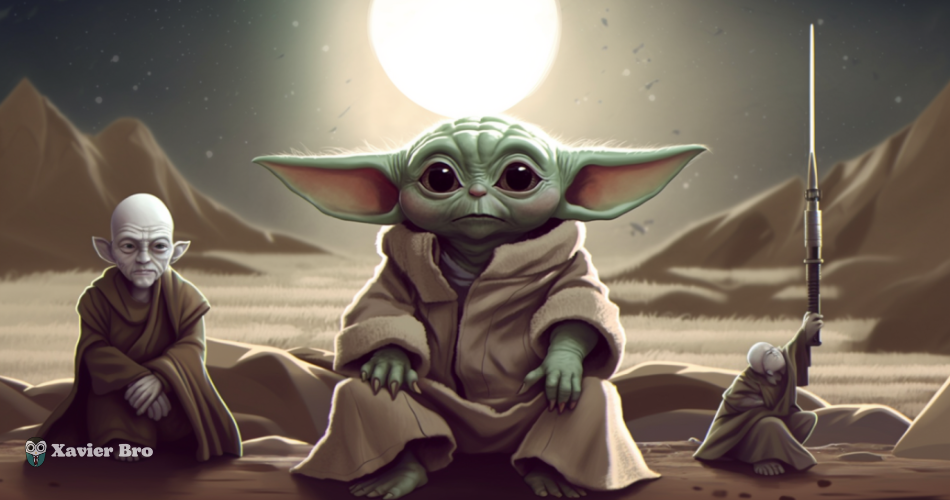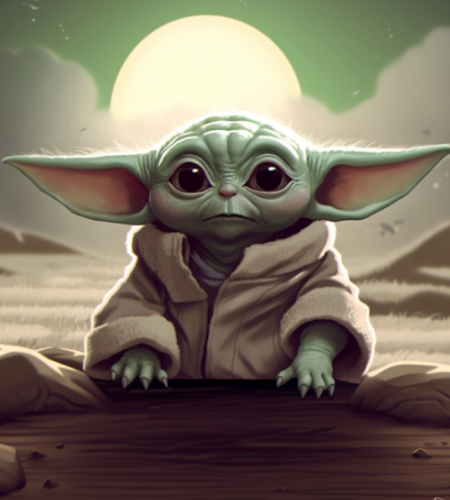Everyone on the internet got very excited when the cute Baby Yoda first appeared on the new Disney show called The Mandalorian. It has big eyes, fuzzy ears, and a sweet little face. So adorable! With the advancements in technology, the trend of a baby Yoda meme spread all over the internet very fast. But then the memes suddenly disappeared from websites like Giphy. This made people confused and upset.
After some time, the Baby Yoda memes came back again. The company Disney owns Baby Yoda, so they needed to figure out all the memes at first. But everyone loves Baby Yoda so much they want to make funny pictures and videos using him. This shows how popular a cute new character can become on the internet!
Key Takeaways
- Baby Yoda became a viral meme sensation, but this led to complications like Giphy removing images due to copyright concerns.
- Memes exist in a complex legal landscape around copyright and fair use, with debates ongoing.
- Corporations want to protect their IP, but overly harsh crackdowns can backfire via the Streisand Effect.
- Memes have cultural value in spreading humor and joy organically. Companies benefit from taking a flexible approach.
- Parody protections allow space for memes to transform copyrighted content legally.
- Memes persist as a bottom-up internet culture that will evolve despite legal barriers.
The Rise in Popularity of Baby Yoda
Though referred to as Baby Yoda, this lovable creature is not a young version of the iconic Star Wars character Yoda. He is simply a member of the same unnamed species, with childlike features that tug at heartstrings everywhere.
When he appeared on screen in The Mandalorian, it was impossible not to be dazzled by his cute giggles, curiosity, and resemblance to Yoda. Fans were hungry for more of this adorable alien, spawning endless memes using images and footage from the show. On social media, people inserted Baby Yoda into various scenarios – sipping broth, using Force powers, and riding in a backpack.
The possibilities were endless. Even professional media outlets wanted in on the action, with publications like Vulture creating galleries of delightful Baby Yoda meme. The sudden influx of Baby Yoda viral content illustrates how rapidly a character can become popular online.
Baby Yoda went from an unknown new character to an absolute internet darling in only a few days. When something is this cute and lends itself easily to humor and meme creation, it’s no surprise the obsession spreads like wildfire.
Cracking Down on Baby Yoda Memes
But all the love for Baby Yoda also caused some problems. Big websites started taking down Baby Yoda pictures and GIFs. This made people who make memes mad and confused.
Giphy was one of the first sites to remove Baby Yoda GIFs from their website. News sites like BBC reported this. Now, places like Vulture could not use GIFs in their stories about Baby Yoda memes. Why did this happen? It was because of worries about copyright rules and permission.
Giphy later apologized and put the Baby Yoda GIFs back on their site. But this shows there is still a big fight about copyright rules and internet culture.
The Wider Landscape of Memes and Copyright
This back-and-forth around Baby Yoda is just one example of the complex copyright issues impacting memes and viral media. After all, memes often use recognized images and characters to create funny commentary or cultural connections. But this can stray into legally murky territory.
Looking wider, there are a few factors impacting the current meme landscape:
- Overly stringent copyright claims: Media powerhouses like Disney want to protect their intellectual property, but harsh crackdowns on harmless memes can feel at odds with fan culture. There needs to be a middle ground.
- Fair use arguments: Meme creators and platforms argue many viral images/clips constitute fair use, allowing unlicensed sharing of copyrighted content in certain contexts like parody. However, fair use is decided case-by-case.
- Evolving social media policies: Platforms like Facebook and Twitter have faced pressure to respond proactively to copyright claims and remove content. But their blanket approach has challenged free expression.
- Monetization debates: As memes become big business, there are debates about who has the right to profit from viral content. Should corporations be able to monetize memes using their IP?
Looking at the broad level, there are no easy answers to balancing copyright restrictions with internet culture. However, when memes are created and shared without commercial intent, many argue this should fall under fair use that benefits wider audiences.
The Future of Baby Yoda Memes
In the future, Baby Yoda memes will probably keep being popular as he shows up in new episodes of The Mandalorian. Disney is being a bit more relaxed about rules now. They are even selling official Baby Yoda toys for the holidays!

But big companies and websites still need to figure out the right balance between copyright rules and what fans want to create. When Giphy first took down and then brought back Baby Yoda GIFs, it showed there is still confusion about handling internet memes.
For people who love making memes, none of these legal fights will stop the fun of seeing Baby Yoda drink soup or ride in his bag. Memes now have a life that continues even with copyright rules. If creative fans keep imagining new memes, Baby Yoda’s cute face will make the internet smile!
The Magic of Memes and Virality
Even with worries about copyright, one thing is true – memes have become very important in culture today. When something gets shared and goes viral, it makes people happy.
Because of this, big companies like Disney should be more flexible. Instead of always saying no to people using their characters in memes, they should see it as free advertising from fans. If Disney had tried to stop all Baby Yoda related meme immediately, they would have missed out on much excitement online.
Memes give companies something that money can’t buy. They come from fans who just want to share something fun. Even if rules try to limit memes, the internet will always find new creative ways to keep that magic going. The best thing big companies can do is celebrate their fans by making great memes!
The ‘Streisand Effect’ and Corporate Overreach
When big companies like Disney are very strict about limiting memes, it can backfire. It draws more attention to the viral memes they wanted to stop sharing. This is called the Streisand Effect.
The effect shows that when you try to censor or delete content online, it can make more people see and share it instead. Companies who get too controlling over memes about their characters risk causing this Streisand Effect.
Instead of rushing to take down memes right away, corporations should think about how viral memes affect their brand and reach. In many cases, memes give companies free, positive publicity that fans create. Some brands have success taking a relaxed approach or even joining in on meme culture themselves. This strengthens the relationship with their online community.
The Importance of Parody Protections
One way memes can use copyrighted stuff legally is through parody. When memes change media clips or images to be funny, it counts as a parody. This falls under fair use rules that allow unapproved use in some cases.
But the parody protection only goes so far. Memes simply reposting copyrighted works without adding new humor or comments don’t qualify as true parody. There are debates around how much a meme can make money before losing fair use cover. Still, in a broad sense, parody carves out important legal space for memes to spread creativity.
Striking a Balance in the Social Media Age
Social media lets memes spread broader and faster than ever. But it has also increased legal fights, with pressure on platforms to react to copyright claims. Finding the right balance between protecting IP and encouraging creativity needs better teamwork.
Instead of fighting, social media sites, meme makers, and big companies can work together to shape fair rules. Compromises could let non-commercial viral memes spread more naturally. With a more thoughtful approach, copyright can be protected while celebrating memes’ cultural joy.
Rules don’t have to ruin the fun! When everyone collaborates, memes can keep spreading widely while respecting IP rights. There are ways to allow creativity to thrive, unite people, and uphold laws through cooperation, not opposition.
Crazy Facts
- The first internet meme is credited to Godwin’s Law in 1990, stating online discussions will inevitably lead to Hitler/Nazi comparisons.
- The most popular meme template of all time is the Distracted Boyfriend meme, based on a stock photo with over 700 million views online.
- Memes don’t just spread virally – researchers have found they evolve like a biological organism, mutating and adapting over time.
- Videos with meme references in the title receive over 50% more views on YouTube than videos without memes.
- The longest-running meme is “All Your Base Are Belong To Us,” which originated from a 1989 video game translation error.
- Memes have decided elections, like “Hope” posters for Obama to “Pokemon Go To The Polls” for Hillary Clinton.
The Bottom Line
The cute Baby Yoda became a huge meme sensation online. But this led to fights over copyright rules for memes. Companies want to protect their characters, but being too strict can backfire. Memes spread joy and shouldn’t be stopped. Hopefully, companies will work with meme makers to balance rules and creativity. Memes are an essential part of internet culture. With teamwork, meme magic can continue spreading smiles everywhere!
FAQs about Baby Yoda Meme
How did baby Yoda get famous?
Baby Yoda made its name due to its cuteness, appearance, etc., along with the humor, expressions, versatile formats of sipping the soup and looking up memes, and the Disney series.
Did the creators of the Mandalorian anticipate the popularity of Baby Yoda?
No, they didn’t anticipate the popularity of Baby Yoda; instead, they wanted to keep it secret to prevent it from spoilers and to boost its market, etc.
I hope so you enjoy our article, do check out more of our amazing articles.
